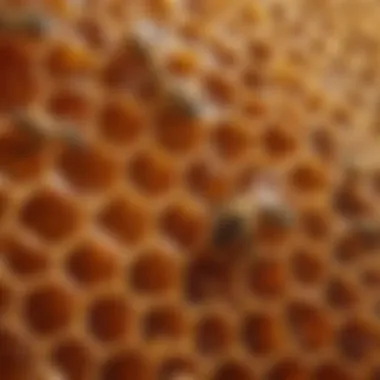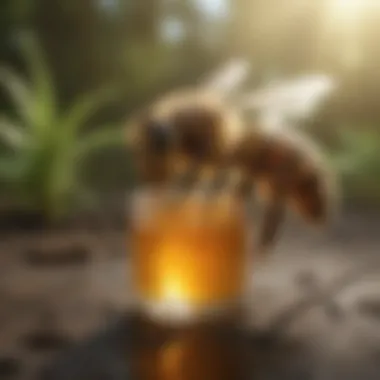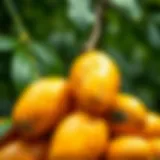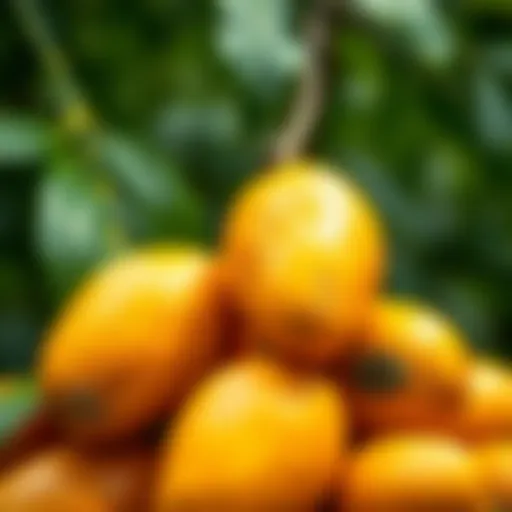The Intricate Process of Honey Production by Honey Bees


Intro
Honey production by bees is an intricate symbiosis between biology and ecology. Understanding the process unveils the remarkable adaptations of honey bees, their interactions with flowers, and the transformations that turn nectar into honey. This article aims to illuminate the steps involved in honey production, shedding light on the fascinating world of honey bees and the implications for agriculture and ecological sustainability.
Key Concepts and Terminology
Basic Definitions
To grasp the complexities of honey production, it is essential to define a few key terms. Nectar is the sugary fluid produced by flowering plants, attracting bees and other pollinators. Pollen is another byproduct of flowers, containing proteins vital for bee nutrition. The hive is a structure where bees live and work, while colonies refer to groups of bees, typically managed by a queen. Understanding these terms allows for a clearer picture of how honey bees operate within their environment.
Historical Context
Honey has been harvested for thousands of years. Evidence suggests that ancient civilizations valued honey not just for its sweetness but also for its medicinal properties. The domestication of honey bees likely occurred around 3000 B.C. in Egypt. This historical background offers insights into the longstanding relationship between humans and bees, emphasizing the need for sustainable practices in modern agriculture to preserve this vital connection.
Recent Innovations and Trends
Technological Advancements
Over recent years, technological advancements have played a crucial role in enhancing our understanding of honey production. Innovations such as hive monitoring systems utilize sensors to track bee health and environmental conditions. These tools allow beekeepers to optimize the production process, ensuring healthy bee populations and increased honey yields. Additionally, research into genetic diversity among bee populations is opening new avenues for improving resilience against pathogens and climate change.
Sustainable Practices
Sustainability is becoming a cornerstone of modern apiculture. Practices such as organic farming, which eliminates synthetic pesticides, are vital for the health of honey bees. Beekeepers are increasingly adopting methods that support bee well-being and biodiversity, such as planting hedgerows and wildflower strips. These sustainable practices not only benefit honey production but also enhance local ecosystems, showcasing the interconnectedness of agriculture and nature.
Practical Applications and Techniques
Step-by-step Guides
To successfully engage in honey production, beekeepers can follow these foundational steps:
- Selecting a Location: Choose an area with abundant flowers and minimal pesticide use.
- Choosing the Hive: Common types are Langstroth and top-bar hives.
- Installing Bees: Purchase a nucleus colony or package bees from a reputable source.
- Maintaining the Hive: Regularly inspect hives for health, pests, and signs of honey production.
- Harvesting Honey: Use an extractor and ensure proper care to keep honey pure.
Case Studies
Several case studies illustrate successful honey production. For instance, in Tuscany, Italy, beekeeping is intertwined with local agriculture, where farmers plant wildflowers to boost bee health. This interdependence showcases the positive outcomes of sustainable practices in increasing honey yields while supporting biodiversity.
"Sustainable beekeeping practices not only enhance honey production but also strengthen our ecosystems"
This article presents a multifaceted view of honey production, emphasizing the biological, ecological, and agricultural aspects at play. Understanding this intricate process is vital for both enthusiasts and professionals in agriculture, shining a light on the delicate balance between human activities and the natural world.
Intro to Honey Production
Honey production is a remarkable process that showcases the intricate behaviors of honey bees and their crucial role in our ecosystem. In this section, we will highlight the importance of understanding how honey is produced and the various factors that contribute to this complex process. Knowledge of honey production can greatly benefit both agricultural practices and ecological sustainability.
By exploring this subject, we can appreciate the significant relationship between honey bees and flowering plants. Their interaction facilitates not only honey production but also the pollination of crops, which is essential for global food security. With the decline of bee populations reported in recent years, awareness of their role in honey production emphasizes the need for conservation efforts.
Key elements to consider include the biological mechanics at play during honey production, the various roles of bees within a colony, and the environmental factors that influence this process. Understanding these aspects can lead to better beekeeping practices, enhancing both productivity and sustainability in agriculture. Moreover, by learning about these processes, farmers and enthusiasts can adopt strategies that help maintain healthy bee populations and promote biodiversity in their regions.
Overall, the study of honey production is not only essential for apiculture but also for grasping the broader implications of pollinator health in relation to agriculture and biodiversity. In the sections that follow, we will delve deeper into the biology of honey bees and the various stages of nectar collection and conversion, all of which contribute to the delightful substance we know as honey.
Biology of Honey Bees
Understanding the biology of honey bees is crucial for comprehending their role in honey production and the overall ecosystem. The anatomy and functions of different bee castes contribute to efficient hive operations and the conversion of nectar into honey. This section will also explore how their biological structures enable honey bees to thrive in their environment, further enhancing their pivotal role in pollination and agriculture.
Bee Anatomy Related to Honey Production
The anatomy of honey bees directly facilitates honey production. Notably, honey bees possess specialized body parts that work in unison to collect nectar and transform it into honey.
- Proboscis: This elongated structure allows bees to reach deeply into flowers to extract nectar. Its flexible nature helps bees gather nectar from various flower types.
- Mandibles: While primarily used to chew wax for building honeycombs, mandibles play a role in manipulating flowers during nectar extraction.
- Honey Stomach: This unique organ stores nectar temporarily. It is separate from the bee's digestive stomach, allowing them to transport nectar back to the hive without processing it initially.
These anatomical features are fundamental for honey collection and showcase how biological design maximizes efficiency in nectar gathering, central to honey production.
Roles within the Colony
Within a honey bee colony, various roles contribute to the structure and operation of the hive. Each caste has distinct functions, vital for honey production and the colony's survival.
Queen


The queen is the central figure in a honey bee colony. Her primary role is reproduction, allowing the colony to thrive and expand. A significant characteristic of the queen is her ability to lay thousands of eggs daily, ensuring high colony population.
- Key Characteristic: She is the only fertile female in the hive, which solidifies her influential position.
- Unique Feature: The queen produces pheromones that communicate the health of the colony and regulate worker behavior.
- Advantages: Her prolific laying contributes to colony growth, which is essential for honey production during peak seasons. Each new generation of bees ensures a ready workforce for foraging and honey processing.
Worker Bees
Worker bees perform nearly all essential tasks within the hive. From nurse bees caring for larvae to foragers collecting nectar, their versatility is vital for the colony's productivity.
- Key Characteristic: They are non-reproductive females, which means their energy is entirely devoted to colony welfare.
- Unique Feature: Worker bees have specialized glands that produce beeswax, used for constructing honeycomb.
- Advantages: Their ability to fill various roles, including foraging, cleaning, and guarding, allows for a highly functional and productive environment, directly supporting honey production.
Drones
Drones serve as the reproductive male bees of the hive. Their primary function is to mate with a queen during the breeding season.
- Key Characteristic: Drones are noticeably larger than worker bees, and they have no stinger, making them less involved in hive defense.
- Unique Feature: They exist solely for reproduction; once their purpose is fulfilled, they are often expelled from the hive by worker bees.
- Advantages: While their role is limited, drones are essential for genetic diversification, supporting the overall health of the colony, which indirectly influences honey production.
In summary, the biology of honey bees, from their anatomy to the defined roles within the colony, is integral to the fascinating process of honey production. A comprehensive understanding of these aspects reveals how these remarkable insects maintain their colonies and fulfill their ecological responsibilities.
The Role of Nectar
Nectar plays a pivotal role in honey production, serving as the primary raw material for bees. Its significance extends beyond mere sustenance, reflecting intricate relationships between flowers, bees, and the ecosystem at large. The transformation of nectar into honey is a fascinating journey, showcasing the vital interdependence of species.
What is Nectar?
Nectar is a sweet liquid produced by flowering plants. It contains sugars, primarily fructose and glucose, as well as various amino acids, vitamins, and minerals. This composition makes nectar an ideal source of energy for honey bees. Different plant species produce nectar that varies in flavor and concentration, affecting the final taste of honey.
Bees collect nectar primarily through their long proboscis, which allows them to extract this sugary liquid from flowers. Once inside the bee's body, nectar undergoes several transformations before becoming honey, highlighting its role in the species' entire lifecycle.
Floral Relationships and Pollination
The relationship between bees and flowers is both direct and symbiotic. Bees visit flowers to collect nectar, and in the process, they facilitate pollination. As bees move from bloom to bloom, they transfer pollen, aiding in the reproduction of plants. This process is crucial for many crops, directly impacting agriculture productivity.
- Pollinator Attraction: Flowers use bright colors and scents to attract bees, enhancing nectar collection.
- Nectar Guides: Many flowers have patterns that lead bees to nectar, optimizing foraging.
- Mutual Benefits: While bees obtain nectar, flowers benefit from pollen transfer, ensuring species propagation.
Without the nectar that these floral relationships provide, honey production would not occur. As such, understanding the characteristics and the ecological context of nectar is essential for appreciating its role in honey production. The intricacies of these interactions underline the importance of protecting both bee populations and their floral resources for sustainable agriculture and biodiversity.
Nectar Collection Process
Nectar collection is a critical activity in the life of honey bees that directly affects honey production. This process not only contributes to the bees’ diet but also enables them to convert floral nectar into honey, an essential resource for their survival. Understanding the methods and significance of nectar collection provides insights into the fascinating relationship between bees and flowers, and how this interaction sustains ecosystems.
Foraging Behavior
Foraging behavior encompasses the strategies that honey bees use to find and gather nectar from various flowers. Worker bees are the primary foragers, venturing out from the hive to search for sources of nectar. They have excellent vision, able to see ultraviolet light, which is invisible to humans. This ability helps them locate flowers, particularly those that are rich in nectar.
When foraging, bees use specific cues such as scent and color to identify suitable flowers. It is remarkable that they can recognize the most productive plants and preferentially exploit them. Foraging trips can last anywhere from several minutes to hours, depending on environmental conditions and resource availability.
Bees collect nectar using their proboscis, a specialized mouthpart that acts like a straw. They store the collected nectar in a special stomach called the honey stomach. This adaptation allows them to transport nectar back to the hive efficiently while being able to feed themselves during the journey if necessary. During intense foraging seasons, a single worker bee may visit hundreds of flowers in one day, often completing several rounds of collection.
Communication Through Dance
Communication is essential for efficient nectar collection, and honey bees have developed specific methods to convey information about nectar sources. One unique form of communication is the waggle dance, performed by forager bees upon their return to the hive. This dance encodes information about the distance and direction of the flower patches where nectar is abundant.
During the waggle dance, the bee moves in a figure-eight pattern. The duration of the waggle phase indicates how far the flowers are, while the angle of the dance communicates direction relative to the sun. Other bees observe this dance and can interpret the information, allowing them to follow the forager to the nectar source.
Moreover, the vibrational signals included in the dance might also influence the enthusiasm of the hive. A lively waggle dance can lead to a significant increase in the number of workers heading out to collect nectar. This method of communication ensures that foraging efforts are coordinated among the colony, which maximizes efficiency in nectar collection.
“The intricate communication methods of honey bees highlight their social structure and the importance of teamwork in gathering essential resources.”
In summary, the nectar collection process is intricate and crucial for honey production. Understanding the foraging behavior and communication techniques enhances appreciation for the efficiency of honey bees in their production of honey. As agricultural practices continue to evolve, recognizing these natural processes holds significance for promoting pollinator health and sustainability.
From Nectar to Honey
The transition from nectar to honey is a fundamental aspect of honey production, representing not only the transformation of a simple liquid into a substance enjoyed by many but also the intricate biological and chemical processes involved. This stage is essential as it defines the quality of honey and contributes to its unique flavor and nutritional properties.
Honey bees begin their work by gathering nectar, a sweet liquid exuded by flowers, which contains a mix of sugars and essential nutrients. As they collect nectar, they also help with pollination, impacting the ecosystem positively. The conversion of nectar into honey relies heavily on the characteristics of the nectar itself, including its sugar composition and water content. The ability to transform nectar into honey efficiently is a skill that has evolved in honey bees over millions of years, ensuring their survival and the sustainability of their colonies.
Enzymatic Processes in Honey Production
Once the nectar is collected, it undergoes a fascinating transformation inside the bee's body. The primary enzymatic process relevant here is the conversion of sucrose into glucose and fructose. This step is critical as honey is primarily composed of these simpler sugars. The enzyme invertase plays a significant role in this process.


- Salivary Glands: When a bee collects nectar, it stores it in its honey stomach. The nectar mixes with saliva, which contains invertase.
- Enzyme Action: As the bee continues to participate in foraging, the nectar's composition alters due to the action of invertase, leading to the breakdown of sucrose.
- Consistency Changes: This breakdown changes the nectar's consistency and begins its transformation into honey.
It is important to note that this enzymatic action not only changes the sugar profile but also impacts the honey's color, flavor, and aroma. These factors contribute to the final product's quality and can vary greatly depending on the floral source of the nectar. Additionally, other enzymes, such as diastase and glucose oxidase, introduce further complexity by aiding in the preservation of honey and contributing to its antibacterial properties.
Evaporation Methods
After the enzymatic processes, the next critical step involves reducing the water content of the nectar. Honey initially consists of about 80% water, but for it to be stored properly in the hive, its moisture content needs to drop to about 18%. This is achieved through evaporation, which is facilitated by several methods employed by the bees.
- Warming the Nectar: Honey bees increase the temperature in the hive through their bodies. By clustering together and vibrating their wings, they create warmth that helps evaporate excess water.
- Air Circulation: The bees fan their wings to circulate air in the hive. This airflow is essential as it promotes evaporation, helping to remove moisture from the nectar.
- Storage in Honeycomb: Once the nectar's water content has been sufficiently reduced, bees store it in hexagonal beeswax cells, shaping the honeycomb. The structure is vital as it provides the optimal conditions for honey storage, preventing fermentation and spoilage.
Through these evaporation methods, bees ensure the longevity and quality of honey. The final honey produced is not just a product of the natural processes involved but also a reflection of the bees' hard work and efficiency, demonstrating their role as crucial contributors to both agriculture and the environment.
Honey Storage and Use
Honey storage is critical not only for honey bees but also for beekeepers and consumers. The storage process ensures that honey maintains its quality and nutritional value over time. Honey is a natural preservative, mainly due to its low moisture content and acidic pH, which help prevent the growth of microorganisms. Therefore, understanding honey storage methods can significantly enhance both its usability and longevity.
Honeycomb Architecture
Honeycomb structures are a remarkable feat of engineering, created by honey bees for storage. The hexagonal cells serve several purposes including housing larvae, storing pollen, and, importantly, holding honey. The geometry of the hexagon is particularly efficient; it provides maximum storage with minimal material use. This architecture helps in maintaining the integrity of honey by reducing the necessary space and minimizing exposure to air, which can lead to spoilage.
- Materials Used: Beeswax is the primary material for honeycomb construction. Worker bees secrete wax from their glands, chew it, and mold it into the familiar shapes.
- Temperature Control: The bees regulate the temperature in the hive, ensuring that the comb remains at an ideal state for honey storage.
Proper construction and maintenance of the honeycomb cells directly impact the quality of honey. Mismanagement can lead to issues such as fermentation or crystallization, which affects the taste and texture of honey.
Honey's Role in the Bee Colony
Within the bee colony, honey serves as the central food source. It provides energy for adult bees and ensures the survival of their young.
- Energy Requirements: Honey is rich in carbohydrates, primarily fructose and glucose, providing the necessary energy for bees during foraging and other activities.
- Winter Sustenance: During colder months, when flowers are scarce, honey becomes crucial for the survival of the colony. Bees rely on their stored honey to fuel their metabolic processes through winter.
- Colony Coherence: The availability of honey helps maintain colony strength, allowing for continued reproduction and growth. In times of lower nectar availability, the bees turn to stored honey, ensuring their resilience.
Beekeepers who understand the significance of honey storage and its architectural nuances can greatly enhance the health and productivity of their colonies. Moreover, an awareness of honey’s role within the hive emphasizes the interconnectedness of bee survival and sustainable beekeeping practices.
The quality of honey storage is not merely about preservation; it reflects the health and sustainability of the entire hive system.
By implementing proper techniques for storage and recognizing the importance of the honeycomb structure, beekeepers can assure both quality honey production and bee wellbeing.
Harvesting Honey
The process of harvesting honey is essential in understanding how honey bees contribute not only to their own survival but also to human agriculture. Harvesting allows beekeepers to collect honey while ensuring that the hive remains functional and healthy. When done correctly, this practice offers multiple benefits including the production of high-quality honey, support of local ecosystems, and the promotion of bee health.
Beekeeping Practices and Ethics
Beekeeping is more than just a hobby; it is an important agricultural practice that requires a deep understanding of bee biology and behavior. Responsible beekeeping practices ensure that honey production is done ethically. For instance, beekeepers must monitor their hives for signs of disease and ensure that bees have sufficient stores of honey for their own survival, especially during winter months. This means taking honey only when extra supplies are available.
Utilizing non-invasive methods during honey extraction is critical. For example, replacing removed honey frames with empty ones can help maintain hive balance. By prioritizing the welfare of the bees, beekeepers contribute to sustainable honey production.
Sustainable Harvesting Techniques
Implementing sustainable harvesting techniques is crucial for the long-term health of both honey bees and the environment. One effective method is to practice selective honey removal. Instead of taking all honey from a hive, beekeepers can leave a percentage for the bees. This ensures that the colony can thrive after the harvest.
Another strategy involves timing the harvest appropriately. Harvesting honey at the right moment minimizes disruption to the bees. Beekeepers should harvest at times when nectar flow is strong to allow for replenishment.
"Sustainable practices not only support bee health but also enhance the quality of the harvested honey."
Finally, regular hive inspections help identify any potential issues before they become severe. By monitoring the health of bee colonies, beekeepers can take action early, leading to better harvesting outcomes.
In summary, harvesting honey is a practice that must be approached thoughtfully. By balancing the needs of the honey bees with the demands of production, beekeepers can ensure a productive, ethical, and sustainable approach to honey collection.
Health Benefits of Honey
Honey is not merely a sweetener; it is a complex substance with an array of health benefits. Understanding these benefits is crucial for anyone interested in the nutritional and medicinal properties of honey. The focus here will be on the nutritional composition and specific medicinal properties that enhance its value beyond the kitchen.
Nutritional Composition of Honey
Honey is composed primarily of sugars, which include fructose and glucose. These sugars provide a quick source of energy. Furthermore, honey contains essential vitamins and minerals, such as vitamin B6, calcium, and magnesium. These micronutrients, while present in smaller amounts compared to other food sources, contribute to overall health.
In addition to vitamins and minerals, honey also has antioxidants, which play a vital role in fighting oxidative stress. This is important because oxidative stress is linked to numerous chronic diseases.
The unique composition of honey varies depending on its floral source. Here are some key components in honey's nutritional profile:


- Fructose: Approximately 38% of honey's composition, this sugar provides sweetness and energy.
- Glucose: About 31%, glucose is another sugar that contributes to the quick energy release associated with honey.
- Water: Roughly 17-18% of honey's weight is water, which affects its texture and flavor.
- Antioxidants: Depending on the type, honey can contain flavonoids and phenolic acids that reduce the risks of heart disease.
Overall, the nutritional aspects of honey make it a beneficial addition to various diets, offering both immediate energy and long-term health support.
Medicinal Properties of Honey
Beyond its nutritional elements, honey is known for its medicinal properties. Its use in traditional medicine spans centuries, underscoring its significance in human health. Honey has several known effects that warrant attention.
- Wound Healing: Honey has been studied for its effectiveness in treating wounds and burns. It maintains moisture in the wound and prevents infection, facilitating faster healing processes. The antibacterial properties of honey are primarily due to the presence of hydrogen peroxide and low pH.
- Cough Relief: Research indicates that honey can be as effective as certain cough medications for alleviating cough symptoms, particularly in children. It coats the throat and soothes irritation, making it popular in home remedies.
- Digestive Health: Honey contains prebiotics, which support the growth of good bacteria in the gut. This can improve digestive health and assist in balancing gut flora.
- Anti-inflammatory Effects: The antioxidants in honey not only help to prevent chronic diseases but also possess anti-inflammatory properties. Regular consumption of honey may aid in reducing inflammation in various body systems.
"Honey has both nutritional and medicinal properties that offer lasting benefits to health when consumed wisely."
Challenges Facing Honey Bees
Honey bees are crucial to our ecosystems and food production. However, they face several significant challenges that threaten their survival and, by extension, our agricultural systems. Understanding these challenges is vital for apiculture and sustainable farming practices. The well-being of honey bees is not just a concern for beekeepers; it has implications for biodiversity, crop yields, and overall food security. Thus, examining the specific threats to honey bees is essential.
Pesticides and Environmental Impact
One of the pressing issues affecting honey bee populations is the widespread use of pesticides. These chemicals are often employed in agriculture to control pests that threaten crops. However, many pesticides are systemic, meaning they are absorbed by plants and can remain in the nectar and pollen, which bees collect. This poses a direct risk to bees, contributing to decreased populations and impaired health.
Recent studies have shown that certain neonicotinoids, a class of pesticides, are particularly harmful. They disrupt the nervous systems of bees, leading to disorientation and reduced foraging ability. This, in turn, affects the colony's ability to gather food and sustain itself.
Moreover, the environmental impact of chemical use extends beyond direct harm. Pesticides can reduce floral diversity, leading to fewer food sources for bees. Without a varied diet, bees may experience nutrient deficiencies, further weakening their colonies. Farmers concerned about bee conservation must reconsider pesticide application and explore alternative pest control methods.
"Protecting honey bees means looking beyond just their immediate welfare to consider the broader implications of agricultural practices."
Colony Collapse Disorder
Colony Collapse Disorder (CCD) is a phenomenon that has puzzled scientists and beekeepers alike. It refers to the sudden disappearance of the majority of worker bees in a colony, leaving behind the queen and some immature bees. The exact causes of CCD are not fully understood, but research indicates it is likely the result of a combination of factors.
Stressors such as poor nutrition, exposure to pesticides, and diseases play significant roles. For instance, pathogens like the Varroa mite have been linked to decreased bee health. These mites attack bees, feeding on their bodily fluids and transmitting viruses.
The implications of CCD are severe. As colonies collapse, the effects ripple through ecosystems, leading to reduced pollination services and diminished agricultural output. Understanding and addressing CCD is crucial for maintaining healthy bee populations.
In summary, by acknowledging the challenges honey bees face, including pesticide use and Colony Collapse Disorder, we can develop better strategies for their conservation. This not only benefits the bees themselves but also enhances the resilience of our agricultural systems.
The Future of Honey Production
The future of honey production holds significant implications for agriculture, biodiversity, and food security. With the growing awareness of environmental impacts and the plight of honey bees, innovative approaches in beekeeping are crucial. Sustainable practices and research can lead to enhanced honey production while preserving the delicate balance of ecosystems.
Research and Innovation in Beekeeping
Research and innovation play vital roles in shaping the future of honey production. Several areas of focus are emerging, which seek to improve both the efficiency and sustainability of beekeeping.
- Genetics of Bees: Studies are being conducted on the genetic makeup of bee populations. Selective breeding may help develop strains that are more resilient to diseases and climate change.
- Technology Integration: Modern technology is changing how beekeepers manage hives. Digital monitoring systems can track hive health, temperature, and humidity in real-time, allowing beekeepers to respond swiftly to changing conditions.
- Alternative Feed Sources: Research is ongoing to identify alternative feed sources for bees during periods when floral resources are scarce. Nutrient-rich supplements can help maintain bee health and productivity.
- Collaborative Beekeeping: Innovative models, such as community beekeeping, are being explored. These initiatives encourage local communities to collectively manage beekeeping efforts, sharing resources and knowledge.
Incorporating these advancements can not only improve honey yield but also fortify bee populations against adversity.
Global Efforts for Honey Bee Conservation
Globally, there are numerous efforts to conserve honey bees and promote sustainable practices.
- Legislation: Many countries are enacting regulations aimed at reducing pesticide use and protecting bee habitats. Policy changes can create environments more conducive to bee health.
- Public Awareness Campaigns: Raising awareness about the importance of bees is crucial. Educating the public about the role of honey bees in pollination and food production can foster greater support for conservation efforts.
- Research Initiatives: Several international collaborations are focusing on honey bee health. Organizations like the Food and Agriculture Organization (FAO) work to implement research-driven policies for bee conservation.
- Community Involvement: Engaging local communities through workshops and training in sustainable beekeeping practices increases local involvement and commitment.
“Sustainable beekeeping practices open pathways for improved honey production and ensure the longevity of bee populations.”
Continued efforts in education, legislation, and community engagement will be essential. By focusing on these areas, honey production can become resilient, ensuring that bees thrive and meet human agricultural needs.
Ending
The conclusion of this article serves as a vital segment that synthesizes the key elements surrounding the process of honey production by bees. As we have explored, the journey from nectar to honey encapsulates not only the biological intricacies of bees but also the ecological ramifications that arise from their activities. It underscores important considerations regarding honey's role in our ecosystem and the necessity for sustainable practices within apiculture.
By recapitulating the insights discussed, the reader gains a comprehensive understanding of the relationship between honey bees and their environment. This culminates in the realization that bees are not merely producers of honey but integral to maintaining the health of our agricultural landscapes. Their pollination activities support the diversity of flora, which, in turn, sustains various forms of life, including human beings. This vital interdependence reflects on how agricultural practices can benefit from understanding honey bee behavior, enhancing productivity while respecting these insects' needs.
Thus, it is critical to appreciate the significance of adopting sustainable methods for honey production. The considerations surrounding environmental impact and ethical beekeeping practices play a crucial role in ensuring the survival of bees and the continual supply of honey. A balanced approach between harvesting and conservation can lead to more fruitful yields while securing the future of these essential pollinators.
Recapitulation of Key Insights
- Biological Importance: Honey bees exhibit remarkable biological traits that facilitate honey production, like specialized anatomy for nectar collection and enzymatic processes that modify nectar into honey.
- Ecosystem Role: Bees serve an indispensable role in pollination, influencing the growth of plants used in agriculture and contributing to biodiversity.
- Sustainable Harvesting: Awareness of sustainable practices can alleviate the environmental pressures associated with honey production.
Calling for Sustainable Practices
To secure the health of bee populations and ensure a consistent honey supply, embracing sustainable practices in beekeeping is essential. Here are key points to consider:
- Avoiding Pesticides: Minimizing the use of harmful chemicals can protect bees from health hazards.
- Promoting Biodiversity: Encouraging diverse flora around hives enhances the well-being of bees and improves honey quality.
- Educating Farmers: Sharing knowledge about the importance of honey bees and their needs can foster cooperative approaches that benefit both agriculture and apiculture.















